Home | Category: Rabbis, Synagogues and Prayers
SYNAGOGUES
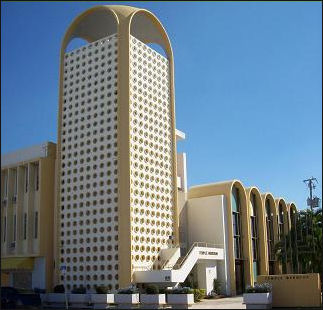
Temple Menorah synagogue in Miami Beach A synagogue is a Jewish place of worship , but is also used as a place to study, and often as a community centre as well. Orthodox Jews often use the Yiddish word shul (pronounced shool) to refer to their synagogue. In the USA, synagogues are often called temples. [Source: BBC, August 13, 2009 |::|]
The local synagogue is the most important organizing force in Judaism. The congregation is led by a rabbi of their choice. The salaried employees usually include the rabbi, the cantor (leader services) and the caretaker. The congregation is typically made up of people who live nearby because Orthodox Jews are not allowed to drive on the Sabbath. Attendance is regarded more as meritorious than a duty.
According to the New Testament, the Talmud and ancient Jewish historians, synagogues were plentiful during the time of Jesus but they did not come into their own until after the Temple was destroyed by the Romans in A.D. 70. Ancient synagogues usually reflected the architectural style of the civilization they were built in.
See Separate Articles TEMPLE OF JERUSALEM (HEROD'S TEMPLE) factsanddetails.com ANCIENT SYNAGOGUES, A.D. 1ST CENTURY factsanddetails.com and factsanddetails.com
Websites and Resources: Virtual Jewish Library jewishvirtuallibrary.org/index ; Judaism101 jewfaq.org ; torah.org torah.org ; Chabad,org chabad.org/library/bible ; BBC - Religion: Judaism bbc.co.uk/religion/religions/judaism ; Encyclopædia Britannica, britannica.com/topic/Judaism; Yivo Institute of Jewish Research yivoinstitute.org ; Internet Jewish History Sourcebook sourcebooks.fordham.edu ; Aish.com aish.com ; Jewish Museum London jewishmuseum.org.uk; Jewish History: Jewish History Timeline jewishhistory.org.il/history Jewish History Resource Center dinur.org ; Center for Jewish History cjh.org ; Jewish History.org jewishhistory.org
RECOMMENDED BOOKS:
“Synagogues: Marvels of Judaism” by Leyla Uluhanli, Judy Lauder, et al. Amazon.com ;
“Synagogues” by Samuel D. Gruber (1899) Amazon.com ;
“The Synagogues of Europe: Architecture, History, Meaning” by Carol Herselle Krinsky Amazon.com ;
“The Ancient Synagogue: The First Thousand Years” by Lee I. Levine Amazon.com ;
“Essential Judaism: Updated Edition: A Complete Guide to Beliefs, Customs & Rituals”
by George Robinson Amazon.com ;
“Guide for the Perplexed” by Moses Maimonides, Andrea Giordani, et al. Amazon.com ;
“Living Judaism: The Complete Guide to Jewish Belief, Tradition, and Practice”
by Wayne D. Dosick Amazon.com ;
“Judaism: History, Belief and Practice” by Dan Cohn-Sherbok Amazon.com ;
“Living a Jewish Life: Jewish Traditions, Customs, and Values for Today's Families” by Anita Diamant, Howard Cooper, et al. Amazon.com ;
“To Be a Jew Today: A New Guide to God, Israel, and the Jewish People”
by Noah Feldman Amazon.com ;
“A History of the Jews” by Paul Johnson, Amazon.com
History of Synagogues
The early Jews worshiped first in tabernacles (temporary sanctuaries used by the Israelites in the wilderness. then in the Temple of Solomon and when that was destroyed they began worshiping in synagogues. The first synagogues are believed to have been built during the Babylonian Exile in the sixth century B.C. when Jews were unable to reach the Jerusalem Temple. The oldest known synagogue lies within the Hasmonean winter palace near Jericho. It was built between 75 and 50 B.C. and was destroyed by an earthquake in 32 B.C.
According to the Worldmark Encyclopedia of Religious Practices: After the destruction of the Jerusalem Temple in 70 A.D., the synagogue, from the Greek meaning "assembly," has served as the site of Jewish worship. (The Hebrew equivalent is bet ha-keneset, or "house of assembly.") In the Talmudic period there arose a parallel institution called bet ha-Midrash, or "house of study," designating a place where Jews went to study the Torah. The two institutions eventually were joined, and in Yiddish, the vernacular of eastern European Jewry, the synagogue is simply called a Schul, or "school." In order to signal that they no longer pray for the restoration of the Jerusalem Temple, Reform congregations often call their house of worship a temple. [Source: Paul Mendes-Flohr Worldmark Encyclopedia of Religious Practices, 2000s, Encyclopedia.com]
The Tabernacle and later the Jerusalem Temples were richly adorned with ornamental art, apparently even pictorial paintings. The biblical prohibition against the fashioning of graven images pertains only to the creation of idols for the purpose of worship (Exod. 20:4; Deut. 4:15–19). Hence, there is a tendency in Jewish tradition to frown upon sculpture, especially if placed in the synagogue, although sculpture is not in itself prohibited. The synagogue is often richly adorned with paintings, although they tend to avoid the depiction of human images. Other ceremonial objects, such as goblets and the cases for mezuzah (door-post) parchments, are also especially crafted by artisans, and there is a long tradition of illuminated Aggadah manuscripts. In contrast to the Temple in Jerusalem, which was built according to precise architectural blueprints, there are no guidelines regarding the construction of synagogues. Hence, the design of synagogues frequently reflects the influence of local architectural styles. [Source:Paul Mendes-Flohr Worldmark Encyclopedia of Religious Practices, 2000s, Encyclopedia.com]
Ark and the Torah
The Torah scroll is usually bedecked in a finely embroidered mantle or decorated encasing and is adorned with specially crafted silver ornaments of bells and a breastplate, or shield, and topped with a crown. The ark containing the Torah scroll should face Jerusalem.
According to the BBC: Every synagogue contains an Ark, which is a cupboard where the Torah Scrolls, which contain the text of the Hebrew Bible, are kept, and a desk from which to read the Torah. The Hebrew words of the Ten Commandments are usually written somewhere above the ark. The Ark is named after the wooden chest which held the stone tablets of the Covenant that God gave to Moses on Mount Sinai. An Eternal Light (called Ner Tamid) hangs above the Ark. This light is always burning, as a symbol of God's presence. It also represents the pillar of fire that guided the Jewish people on their early journey. [Source: BBC, August 13, 2009 |::|]
“The platform and the desk for Torah readings are called the Bimah (pronounced beemar), and in an Orthodox synagogue are in the centre of the building. (In a Reform synagogue, the Bimah is usually close to the Ark.) At the proper moment in the service the Ark is ceremonially opened, and the Torah scroll is carried in procession to the reading desk, unrolled to the reading chosen for the day and laid on the reading desk. It is normal for everyone to stand whenever the doors of the ark are open.” |::|
Parts of a Synagogue

inside a modern synagogue: 1) Ark; 2) the Torah; 3) Ner Tamid; 4) Menorah; 5) Ten Commandments; 6) Rabbi's and Cantor's Seats; 7) Rabbi's Podium; 8) Rabbi's and Cantor's Reading Table; 9) Bimah; 10) Congregational Seating
The main feature of a synagogue is the ark where the scrolls are stored. The ark is similar to a cupboard and traditionally it was placed on a rear wall of the synagogue facing Jerusalem. In front of the ark is the perpetual altar fire. Services are led from the “Bimah” , a platform in front of the ark or in the middle of the building. The sexes are often divided by a partition. Some synagogues have a woman’s gallery on a balcony overlooking the main sanctuary.
Most synagogues also contain Hanuka lamps, replica's of 17th century gravestones, brass chandeliers, and decoration made from silver and carved mahogany. The thick carpet of sand on the floor symbolizes the desert crossed by the Israelites on their journey to the Promised Land. This tradition many scholars believe began during the Spanish inquisition to muffles the sound of footsteps during services. Some synagogues have stained glass windows and elaborate decorations. Synagogue lacks picture as not to break the second commandment against idolatry.
Most synagogues have a main sanctuary, where services are held, with a lofty ceiling. The sanctuary is surrounded by small rooms and offices, where meetings, classes, study sessions and ritual bathing take place. The architecture generally is similar to the architecture of the host community or the place they are originally from.
Synagogue Rituals and Customs
After the destruction of the Temple in A.D. 70, many Temple rituals were incorporated into synagogue activities. Daily services and prayers have traditionally been held at the same times that animal sacrifices were performed at The Temple.
Services and prayers are held everyday, but many members only visit the synagogue on the Sabbath as Christians do with their local church. The liturgical services are often led by laymen. A full service can not take place without a “miryan” , a group of ten men. It is said that God becomes angry if he visits a synagogue and a minyan is not present. Worshipers are required to keep their heads covered during the service. Men usually wear yarmulkes.
Services have traditionally been centered around readings of the scrolls. When the Torah is read the handles are held upright with both hands so that text of the Torah faces the reader. During a synagogue service, everyone stands when the Torah is taken out of the ark. When the Torah scrolls are ceremoniously lifted the congregation declares: “This is the Law which Moses set before children of Israel.” Sephardic Jews have traditionally raised the Torah before it is read while Eastern European Jews raised it after a reading. See Torah Care and Customs.
A flame on a candle or altar lamp is left continually burning in a synagogue to indicate God’s constant presence and as reminder of the golden candlestick that continually burned in The Temple in Jerusalem.
Synagogue Service

Torah reading
According to the BBC: “Synagogue services can be led by a rabbi, a cantor or a member of the congregation. Traditional Jewish worship requires a minyan (a quorum of ten adult males) to take place. In Orthodox synagogues men and women sit separately, and everyone (except young girls) has their head covered. In a Reform synagogue men and women can sit together. [Source: BBC, August 13, 2009 |::|]
“In an Orthodox synagogue the service will be conducted in ancient Hebrew, and the singing will be unaccompanied. In a progressive (Reform, Liberal) synagogue the service will be at least partly in English, there may a choir and instruments, and men and women can sit together. Few British synagogues now have a choir, but they are more common in the USA. Everyone except unmarried women wears a hat in synagogue in order to show reverence to God. (And once unmarried women pass a certain age they usually wear a hat too.) Jewish men always wear hats when they are saying prayers which mention God's name. Observant Jewish men wear a hat almost all the time. The most common hat for men in the synagogue is a small round cap called a yarmulke (Yiddish) or a kippah (Hebrew), but an ordinary homburg or street hat will be accepted. Hats are always available for visitors, but a hair grip comes in handy to keep a kippah on. |::|
“Adult men (i.e. those over the age of 13) often wear a Tallit or prayer shawl for morning prayer. A Tallit has fringes (called tzitzit) on the edges to remind the wearer to observe God's commandments - as commanded by God in the Bible. Throughout the generations to come you are to make tassels on the corners of your garments, with a blue cord on each tassel. You will have these tassels to look at and so you will remember all the commands of the LORD, that you may obey them and not prostitute yourselves by going after the lusts of your own hearts and eyes. Numbers 15:38-40 reads: “Then you will remember to obey all my commands and will be consecrated to your God.” There are several times in synagogue services when people kiss these fringes - for example when the tzitzit are mentioned.” |::|
See Separate Article JEWISH WORSHIP: PRAYERS, PRACTICES AND RELIGIOUS CUSTOMS africame.factsanddetails.com
How The Torah is Used in a Synagogue
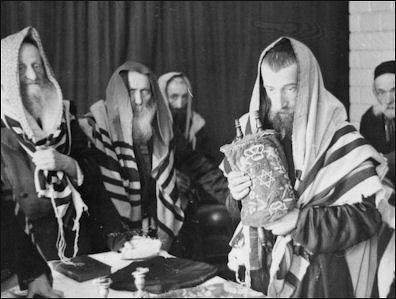
Torah holding
According to BBC: “The Torah scrolls are taken out from the Ark (Aron ha kodesh) and portions read in the synagogue three times each week. On Mondays and Thursdays small sections are read. The main reading is on the morning of Shabbat (Sabbath). Over the course of the year the whole scroll is read in sequence. This begins from the end of Sukkot which is an autumn festival. The special portions for the readings are called parshioth and are usually three to five chapters in length. The reader has to be very skilled to read from the scroll because the letters are written without corresponding vowels. They have to know the portion very well to avoid making mistakes. The reading is conducted using an ancient tune and is sung rather than spoken. [Source: BBC, August 13, 2009 |::|]
“The scrolls are not directly touched when unfurled on the Bimah (raised platform in middle of the synagogue). A pointer or Yad (hand) is used instead. This is in the shape of a hand with an outstretched finger. The reading or chanting is performed by a person who has been trained in this task. However it may be carried out by the rabbi. It is a very great honour for a congregant to be asked to attend at a reading during a synagogue service. This is called having an Aliyah which is Hebrew for going up. The weekly portion or Sedrah is followed by the recitation of part of another of the Jewish holy writings. |::|
“A Sefer Torah is so sacred to Jews it is said that if one is accidentally dropped in the synagogue the whole congregation must fast for 40 days. When Jewish communities have suffered persecution, great efforts would be made to preserve these scrolls. This demonstrates just how symbolically and physically important the Torah is to Jews.” |::|
Praying at a Synagogue
According to the BBC: Much of Jewish prayer consists of reciting the written services aloud in synagogue. Praying in public affirms that a person is a member of a community, and when they do so, an individual puts themselves into the context of other Jews, and to some extent puts their own particular situation aside to put the community first. It's also an act of togetherness with Jewish people who are doing the same all around the world. And attending regular services, and following the order of the prayer book, is a valuable spiritual discipline, and a mechanism that enables a person to spend time with God on a regular basis. [Source: BBC, August 13, 2009 |::|]
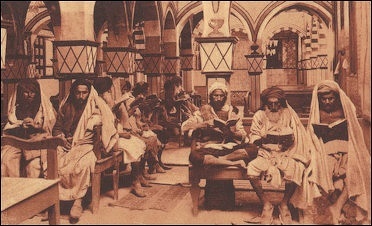
Djerba synagogue in Tunisia
The Jewish prayer book is drawn from the writings of the Jewish people across the ages. It contains the wisdom of great thinkers, and some of the most beautiful Hebrew poetry. For example, this extract from the Morning Service is a profound lesson in the nature of God, as well as an act of worship.
Blessed be He who spoke and the world came into being; blessed be He.
Blessed be He who maintains the creation.
Blessed be He who speaks and performs.
Blessed be He who decrees and fulfils.
Blessed be He who has mercy upon the earth.
Blessed be He who has mercy on his creatures.
Blessed be He who pays a good reward to those who fear Him.
Blessed be He who lives for ever, and endures to eternity.
Blessed be He who redeems and saves; blessed be his name...
Different Practices in Orthodox, Reform and Conservative Judaism
J.M Oesterreicher wrote in the New Catholic Encyclopedia: The traditional service is, except for a few Aramaic interludes, in Hebrew. However, in the typical Reform Temple (the term temple was originally chosen as a substitute for synagogue to disavow hope for the rebuilding of the shrine that was once the pride of Jews) most of the prayers are in the vernacular. Since every congregation is independent, the proportional use of Hebrew and English in Reform and Conservative congregations varies. Traditional Jews will not pray, study Torah, or perform any act of worship unless their heads are covered. If they did otherwise, they would consider it irreverent, to stand slipshod in the presence of the Lord. [Source: J.M Oesterreicher, New Catholic Encyclopedia, 1960s, Encyclopedia.com]
The Orthodox Jews who follow custom rigidly have their heads constantly covered; at services they like to wear hats, whereas Conservatives use "yarmulkes" (Yiddish word for skullcaps), at times of varied colors and beautifully embroidered. Reform Jews wear no head covering, following in this the conventions of Western civilization, where the bared head is a sign of respect.
In Orthodox synagogues men and women are separated. In most Conservative synagogues and all Reform temples they are seated together. In a traditional service Scripture readings and prayers are chanted; in a modernized one, they are recited in a formal manner. In all Orthodox and many Conservative synagogues, priestly descendants (their shoes removed, as was done in the Temple of Jerusalem) chant the Aaronic blessing (Nm6.22–27) over the people. The cantillation, at times amateurish, may jar a modern musically trained ear. In a reformed service, therefore, the rabbi imparts that blessing. There, as elsewhere, a prevailing criterion is decorum.
Conservative and Liberal Judaism Synagogue Practices
According to the BBC: “Conservative Jews regard the Torah as both divine and human, but having divine authority. They believe the Torah was revealed by God but is a human record of the encounter between humanity and God, and the Jewish people's interpretation of God's will. They accept that the commandments in the Torah record the covenant between God and the Jewish people. [Source: BBC, July 24, 2009 |::|]
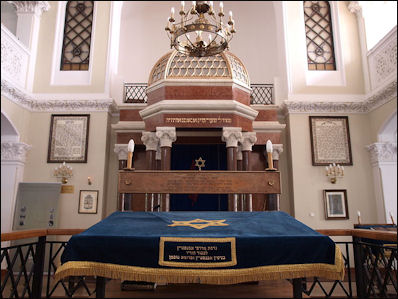
Warsaw Nozyk Synagogue Interior “Local communities and rabbis work together to decide on the practice to be followed in particular synagogues. Conservative services are quite traditional, and mostly in Hebrew. Women and men can play an equal part in Conservative worship. Some Conservative synagogues let men and women sit together, others segregate the genders. However, women count as part of the minyan and can say the Mourner's Kaddish in their own right. |::|
“One UK synagogue describes its services like this: “Our services are davened in the traditional way, using the Singer’s Prayer Book and members are encouraged to lead services, leyn from the Torah and participate. We have mixed seating and both men and women are counted in the minyan, called to the Torah, leyn and read Haftarah. Women do not lead services or wear kippot or tallitot.” The movement accepts women rabbis, although this change caused some American rabbis to break away to found the Union for Traditional Judaism. |::|
“In a Liberal synagogue men and women sit together and take part as equals in all aspects of the service. Much of a Liberal service is taken from traditional Jewish liturgy, with revisions, omissions, modifications and 'many amplifications'. A part of the service is usually in English (although Liberal synagogues now use more Hebrew than in the early days of the movement). There may also be a choir and instrumental accompaniment. Liberal Judaism believes that all festivals and days of celebration or mourning be upheld in tandem with traditional beliefs. |::|
Ancient “Synagogue” Actually a Muslim Palace
In 2010, Israeli archaeologists announced that ruins long thought to be of an ancient synagogue were actually the remains of a palace built by Arab caliphs 1,300 years ago. Associated Press reported: “The site, on the banks of the Sea of Galilee, was identified as a synagogue in the 1950s because archaeologists found a carving of a menorah, a seven-armed candelabra that is a Jewish symbol. But scholars said in a report published this week that the identification was an error, and that the site was a winter palace used by the caliphs of the Umayyad dynasty, the same rulers who built Jerusalem's gold-capped Dome of the Rock. [Source: Associated Press, March 17, 2010 *]

synagogue in Kiev
“Early Arab historians had described the palace, calling it al-Sinnabra, but its location was previously unknown. The new identification came as part of a broader reexamination of the site, which contains ruins dating back to the Bronze Age. The Umayyad caliphs ruled the Islamic world from 661 to 750 A.D., expanding its borders from modern-day Spain to Pakistan. Archaeologists from Tel Aviv University and Hebrew University conducting the new review said this week that the confusion arose from the relatively primitive archaeological techniques of the 1950s. *\
“The palace was also dismantled down to its foundations after the fall of the dynasty, leaving nothing behind but a foundation and few clues to help date the structure. Archaeologists at the time also believed, erroneously, that the early Arab caliphates did not carry out many large-scale building projects. Researchers first began to raise doubts about the origins of the structure in the 1990s, but it wasn't until 2002 that archaeologist Donald Whitcomb from the University of Chicago first suggested that the site might in fact be the missing Umayyad palace. That identification was confirmed by archaeologists this week. *\
“The identification of the structure as a synagogue was based on the image of a menorah that the early excavators found carved into the top of a pillar base. But the scholars behind the new review of the site realized that the carving was a red herring — that surface would have been covered by a pillar in the original structure, so the carving must have been added later. The researchers say it's possible the ruins were later used as a synagogue, or possibly just as a canvas for ancient graffiti. Rafi Greenberg, a professor of archaeology at Tel Aviv University who is directing the project, said the palace's correct identification would help show the architectural continuity between the Roman and early Arab empires. "This is happening at many sites that are being re-dated with better resolution and understanding," he said.” *\
1,600-Year-Old Mosaic at Israeli Synagogue Damaged by Jews
In 2012, vandals badly damaged a rare 1,600-year-old mosaic in the northern Israeli city of Tiberias that formed the floor of an ancient synagogue, smashing parts to rubble and scrawling graffiti. , antiquity officials said Tuesday. There was no claim of responsibility. Experts suspect extremist Jews who object, sometimes violently, to excavations they claim involve ancient grave sites. [Source: Diaa Hadid, Associated Press, May 29, 2012 /*]
Associated Press reported: “The mosaic, was one of the best preserved and beautiful of its period, according to archaeologists. It featured illustrated zodiac signs and the traditional symbolism of a fourth-century synagogue: ritual candelabras and palm fronds. The synagogue's ruins, including its ancient mosaic floor, were in a fenced-off area of a national park in Tiberias, next to the Sea of Galilee It listed the names of the synagogue's chief patrons in ancient Hebrew, Latin and Greek./*\
“Israel Antiquities Authority deputy director Uzi Dahari said a fringe group of ultra-Orthodox Jews were suspected of causing the damage, much of it irreversible. Dahari said the graffiti scrawled across parts of the archaeological site and previous threats against the Antiquities Authority suggested they were the perpetrators. Photographs issued by the Antiquities Authority showed parts of the mosaic floor reduced to gray chunks of rubble. Other photographs showed blue spray paint scrawled over the mosaic, covering ancient Hebrew and Greek letters spelled out in blue, red and beige tiles. Graffiti was also scrawled along rock walls beside the mosaic. Perpetrators also punched a hole in the mosaic between two candelabras. "On every grave, a site," one neatly written Hebrew slogan said. /*\
“Dahari and other archaeologists said it referred to constant accusations by a tiny Jewish hard-line group that the Antiquities Authority was digging up Jewish graves. Disturbing Jewish graves is a deeply offensive act for devout Jews. Archeologists said they have found similar graffiti on other sites. The Hebrew word for "site" is also shorthand for an archaeological site, as in English. An archaeologist who frequently works in the Galilee area, Gilad Kinamon, said ultra-Orthodox Jews frequently turned up to his sites to demonstrate against his work. "It was the best of Jewish art of its time, of the late Roman and early Byzantine period," said Dahari. They ... destroyed what was in front of them without thinking," he said.” /*\
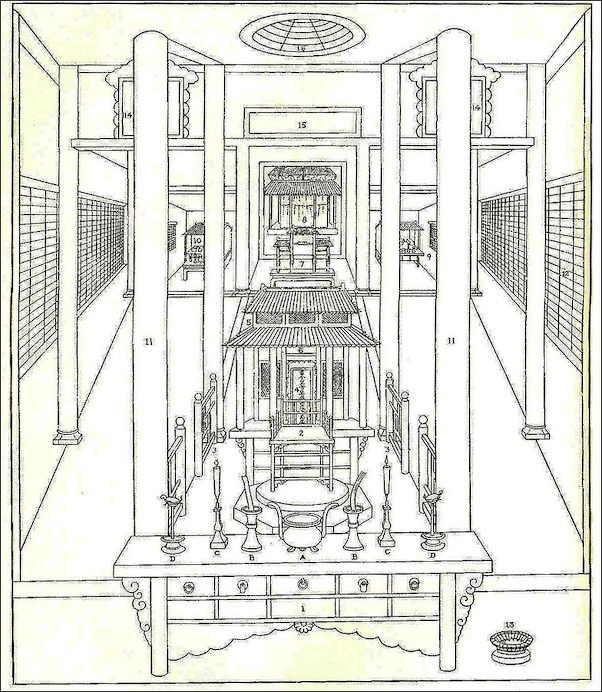
Interior of the Kaifeng synagogue in China: 1 – The main Ceremonial Table (Kung-cho), on which the Wu-kung were laced (A) Censer. (B) Flower-vases. (C) Candlesticks. In addition this table had extra oil-bowl lamps on stands at each end (DD) 2 – The Chair of Moses (Mo-she pan tso), on which the Roll of the Torah was placed, for ceremonial reading 3 – Balustrade (lan-kan) which railed off the ceremonial furniture in the centere of the hall. It extended as far as the inner Sanctuary or Bethel. 4 – The Ch'ing Emperors Tablet (Ta Ch'ing Wan-sui-p'ai), of red and gilt lacquered wood, with inscriptions in gilt Chinese characters. 5 – The Ming Emperor's Tablet (Ta Ming Wan-sui-p'ai). This is not seen in the sketch but was farther in and directly behind the Ch'ing Tablet. 6 – The Dragon Pavilion (Lung-lou). A canopy under which the Ch'ing Tablet rested. It stood on a suitable table, and before it was another smaller table with censer and par of candlesticks. The Ming tablet also had before it a small table on which stood a censer but no candlesticks. 7 – A Tripartite Arch with Hebrew inscription in gold letters. This was in the form of a Memorial Archway (p'ai-fang or p'ai-lou) and stood on a table immediately in front of the Bethel. 8 – The Bethel or Arch of the Revered Scriptures (Tsun Ching K'an). It exterior was square and its interior circular. (The Chinese delegates state it was hexagonal.) In it were the 12 cases (T'ien ching shih-erh t'ung) each of which contained a Roll of the Pentateuch. Frontal drapes (fu yen) hung in front of these Torah cases. 9 – Rack (lung) for the Square Scripture Sections (Fang Ching). 10 – Rack for the Miscellaneous Writings (San Chih). 11 – Wooden pillars, lacquered black. On some of these were hung the vertical couplet inscriptions. 12 – Lattice Partition walls. It was unusual to have them also on both sides of the hall, as well as along the eastern front. The woodwork of the partitions was decorated in read, the upright columns in black. 13 – Stone drain mouth, over which the hands were ceremonially washed by the pouring of water. 14 – Tablets with Hebrew inscriptions in gold letters. The two were indentical, and were above each of the racks containing the Scripture Sections and the Miscellaneous Writings. 15 – Inscription in Hebrew, which hung above the Emperor's Tablet. 16 – Dome above the Chair of Moses. Does this dome suggest a Persian influence?
Image Sources: Wikimedia Commons
Text Sources: Internet Jewish History Sourcebook sourcebooks.fordham.edu; “World Religions” edited by Geoffrey Parrinder (Facts on File Publications, New York); “ Encyclopedia of the World’s Religions” edited by R.C. Zaehner (Barnes & Noble Books, 1959); “Old Testament Life and Literature” by Gerald A. Larue, New International Version (NIV) of The Bible, biblegateway.com; Wikipedia, National Geographic, BBC, New York Times, Washington Post, Los Angeles Times, Smithsonian magazine, Times of London, Library of Congress, The New Yorker, Reuters, AP, AFP, Lonely Planet Guides, and various books and other publications.
Last updated March 2024
